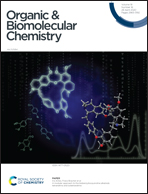Recent progress in (hetero)arene cation radical-based heteroarene modification
Abstract
The transformation of (hetero)arene cation radicals has become a powerful tool for the construction of highly functionalized (hetero)arenes. These (hetero)arene cation radicals could be generated under electrochemical, photochemical or chemical oxidation systems. The in situ generated (hetero)arene cation radicals can be attacked by various nucleophiles, such as (hetero)aromatics and anions, yielding structurally diverse molecules. Recently, a large number of impressive heteroarene modifications have been designed by this strategy. This review summarizes the advances in heteroarene modification via reactions of in situ formed (hetero)arene cation radicals, ranging from 2010 to 2020.

- This article is part of the themed collection: Synthetic methodology in OBC


 Please wait while we load your content...
Please wait while we load your content...